
A leafhopper is the common name for any species from the family Cicadellidae. These minute insects, colloquially known as hoppers, are plant feeders that suck plant sap from grass, shrubs, or trees. Their hind legs are modified for jumping, and are covered with hairs that facilitate the spreading of a secretion over their bodies that acts as a water repellent and carrier of pheromones. They undergo a partial metamorphosis, and have various host associations, varying from very generalized to very specific. Some species have a cosmopolitan distribution, or occur throughout the temperate and tropical regions. Some are pests or vectors of plant viruses and phytoplasmas. The family is distributed all over the world, and constitutes the second-largest hemipteran family, with at least 20,000 described species.

The Mymaridae, commonly known as fairyflies or fairy wasps, are a family of chalcidoid wasps found in temperate and tropical regions throughout the world. The family contains around 100 genera with 1400 species.
Eonessa is an enigmatic genus of bird possibly belonging to bird order Gruiformes and which consists of the single species Eonessa anaticula.

Issidae is a family of planthoppers described by Spinola in 1839, belonging to the order Hemiptera, suborder Auchenorrhyncha superfamily Fulgoroidea.

Nogodinidae is a family of planthoppers. They have membranous wings with delicate venation and can be confused with members of other Fulgoroid families such as the Issidae and Tropiduchidae. Some authors treat it as a subfamily of the Issidae. Some of their key features are a frons ("face") that is longer than wide and a reticulate wing venation. They are less than 2 cm long. The antenna arises well below the eye, has the base clubbed and flagellum unsegmented. The lateral ocelli are outside the margins of the face. The face has carinae on the edge. On the hind leg, the second tarsal segment has an apical spine arising from it. The tibia of the hind leg also has spines towards the tip. An important family character is found in the shape of the male genital structure, a style that is longer than broad. Most members of this family are forest species.

Ledrinae is a relatively small subfamily within the very large and diverse leafhopper family Cicadellidae. Originally placed in its own family, the "Ledridae", it is based on the type genus Ledra.

Lophopidae is a family of fulgoroid plant-hoppers with most species found in tropical South America and Asia.

Deltocephalini is a tribe of leafhoppers in the subfamily Deltocephalinae. Deltocephalini contains 72 genera and more than 600 species.
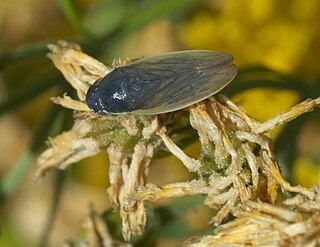
Gyponini is a tribe of leafhoppers in the family Cicadellidae, formerly treated as a subfamily, but now considered to belong within the subfamily Iassinae. Gyponini includes about 60 genera and more than 1,300 described species, located in the Americas.
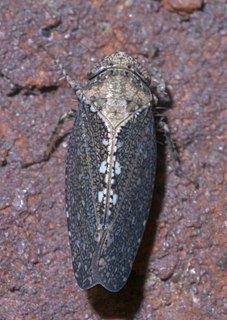
Phlepsiini is a tribe of leafhoppers in the subfamily Deltocephalinae. There are 4 genera and over 80 described species in Phlepsiini.

Coelidiinae is a subfamily of leafhoppers in the family Cicadellidae. There are at least 8 tribes, 108 genera, and over 900 species in Coelidiinae.
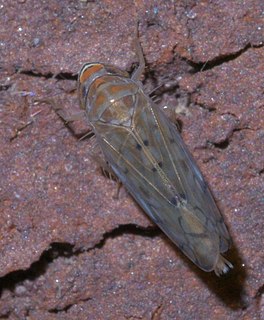
Scaphoideini is a tribe of leafhoppers. There are 64 genera and over 600 described species in Scaphoideini.

Paraphlepsius is a genus of leafhoppers in the family Cicadellidae. Paraphlepsius is in the tribe Pendarini within the subfamily Deltocephalinae. There are around 70 described species in Paraphlepsius.
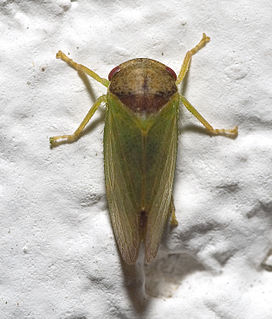
Iassinae is a subfamily of leafhoppers in the family Cicadellidae.
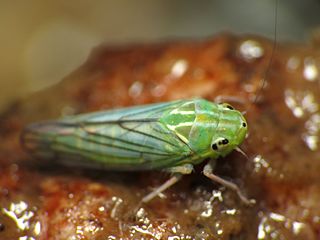
Neocoelidiinae is a small subfamily in the family Cicadellidae (leafhoppers). It was originally included within the subfamily Coelidiinae.

Evacanthinae is a subfamily in the family Cicadellidae (leafhoppers).
Hylicinae is a subfamily in the family Cicadellidae (leafhoppers).
Mileewinae is a small subfamily in the family Cicadellidae (leafhoppers). It is closely related to Typhlocybinae and contains species that were previously part of Cicadellinae.
Neobalinae is a small subfamily in the family Cicadellidae (leafhoppers).
Paralimnini is a tribe of leafhoppers in the subfamily Deltocephalinae. Paralimnini contains 139 genera and over 900 species divided into two subtribes: Aglenina and Paralimnina. The tribe has a cosmopolitan distribution.















